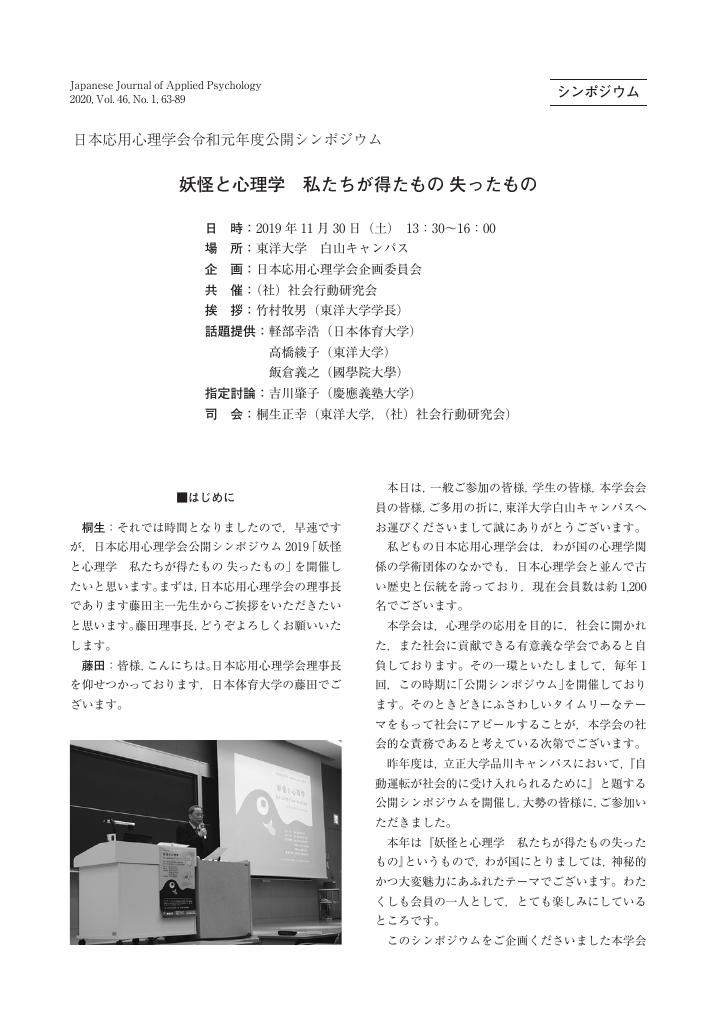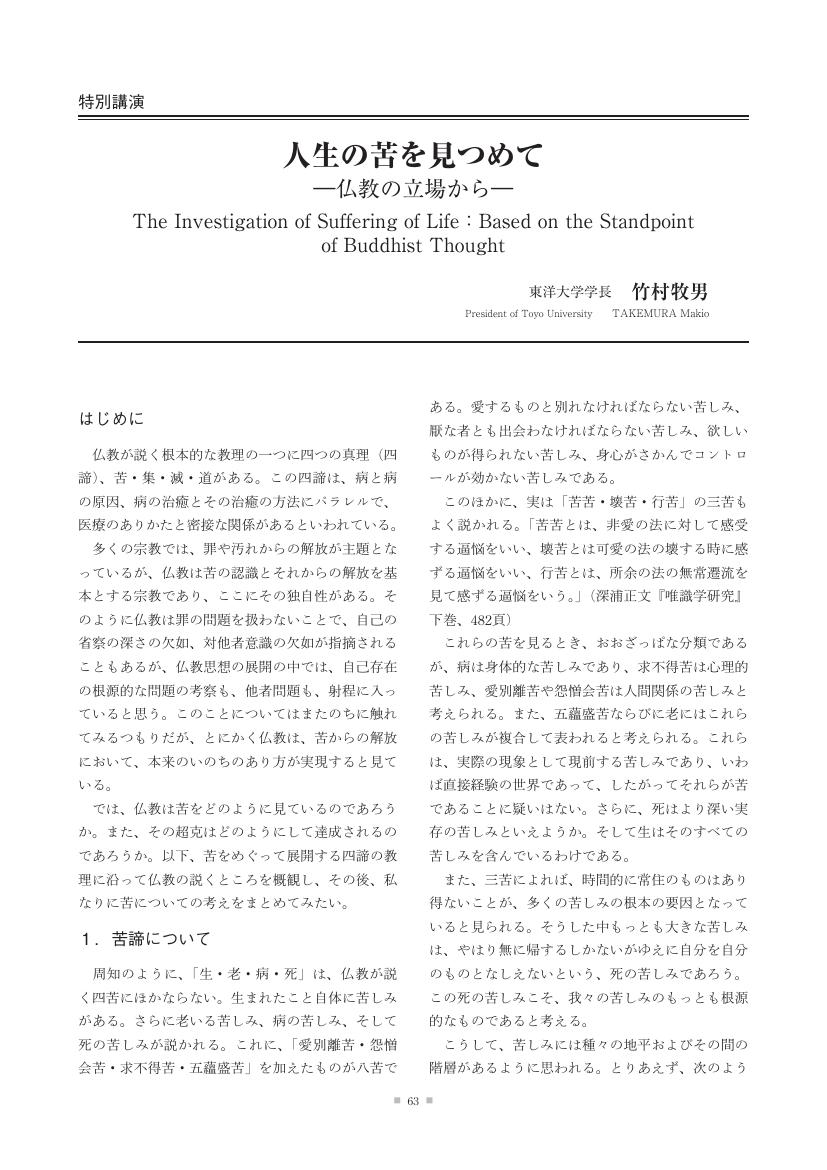2 0 0 0 OA 妖怪と心理学 私たちが得たもの 失ったもの
2 0 0 0 OA 華厳思想と即身成仏(智山教学大会特別講演)
- 著者
- 竹村 牧男
- 出版者
- 智山勧学会
- 雑誌
- 智山学報 (ISSN:02865661)
- 巻号頁・発行日
- vol.48, pp.1-25, 1999-03-31 (Released:2017-08-31)
2 0 0 0 OA 環境倫理と宗教思想―仏教思想の課題について
- 著者
- 竹村 牧男
- 出版者
- 東洋大学「エコ・フィロソフィ」学際研究イニシアティブ(TIEPh)事務局
- 雑誌
- 「エコ・フィロソフィ」研究 = Eco-Philosophy (ISSN:18846904)
- 巻号頁・発行日
- no.7, pp.9-20, 2013-03
1 0 0 0 OA 脱落即現成の哲学─道元思想の核心にあるもの─
- 著者
- 竹村 牧男
- 出版者
- 東洋大学東洋学研究所国際禅研究プロジェクト
- 雑誌
- 国際禅研究 = INTERNATIONAL ZEN STUDIES (ISSN:24338192)
- 巻号頁・発行日
- no.4, pp.7-25, 2019-12
1 0 0 0 IR 私の一冊「親鸞と一遍」/「具体性のヴィゴツキー」
- 著者
- 竹村 牧男 茂呂 雄二
- 出版者
- 筑波大学図書館課
- 雑誌
- つくばね : 筑波大学図書館報 (ISSN:02850117)
- 巻号頁・発行日
- vol.25, no.3, pp.8-9, 1999-12-30
日本の中世という時代に,私はなぜか心ひかれてやまない。その時代は,無の深淵が口を開けた時代,虚無の底に降り立った時代であった。そして虚無の深さにはかりあえるような優れた芸術が産み出された時代でもあった ...L・S・ヴィゴツキー(1896-1934)の名前は心理,教育,言語研究者を除けば,大方には馴染のない名前であろう。この白ロシア生まれのユダヤ人心理学者は,革命の祝祭空間を駆け抜けて,その祭りの後に政治的非難にうちのめされたまま37歳で結核で没したのだが, ...
1 0 0 0 OA 「仏教といのち」
- 著者
- 竹村 牧男
- 出版者
- 東洋大学「エコ・フィロソフィ」学際研究イニシアティブ(TIEPh)事務局
- 雑誌
- 「エコ・フィロソフィ」研究 Vol.8 別冊 (ISSN:18846904)
- 巻号頁・発行日
- no.8, pp.134-138, 2014-03-25
1 0 0 0 OA 西田と大拙の真宗理解をめぐって
- 著者
- 竹村 牧男
- 出版者
- 西田哲学会
- 雑誌
- 西田哲学会年報 (ISSN:21881995)
- 巻号頁・発行日
- vol.12, pp.45-56, 2015 (Released:2020-03-21)
Nishida Kitaro and Suzuki Daisetsu were both born in 1870. Throughout their lives since their adolescence, they shared an intimate friendship and exchange of ideas. Daisetsu discovered in the Pure Land thought of Hōnen and Shinran a distinctive “Japanese Spirituality” characterized by the faith in being saved unconditionally through the absolute compassion of Amita- Buddha. Nishida discussed the theory of salvation in Shin Buddhism in his very last article, “The Logic of basho(Place)and the Religious World-view.” He pointed out that the Buddha in Shin Buddhist doctrine fully transcends us and at the same time embraces us. However, Daisetsu’s and Nishida’s understanding of Shin Buddhism went further than this. Both emphasized that salvation by Amita-Buddha immediately transforms itself into concrete effort to help others. Such understanding is not only a valuable contribution to contemporary doctrinal studies of Shin Buddhism, it more generally points a way to religion’s engagement with society.
1 0 0 0 OA 西田の禅思想をめぐって 逆対応から平常底へ
- 著者
- 竹村 牧男
- 出版者
- 西田哲学会
- 雑誌
- 西田哲学会年報 (ISSN:21881995)
- 巻号頁・発行日
- vol.8, pp.1-19, 2011 (Released:2020-03-23)
1 0 0 0 OA 人生の苦を見つめて 仏教の立場から
- 著者
- 竹村 牧男
- 出版者
- 日本医学哲学・倫理学会
- 雑誌
- 医学哲学 医学倫理 (ISSN:02896427)
- 巻号頁・発行日
- vol.31, pp.63-71, 2013 (Released:2018-02-01)
1 0 0 0 OA 近代日本仏教の一場面 ―井上円了の仏教復興活動について
- 著者
- 竹村 牧男
- 出版者
- 宗教哲学会
- 雑誌
- 宗教哲学研究 (ISSN:02897105)
- 巻号頁・発行日
- vol.34, pp.29-43, 2017-03-31 (Released:2017-06-01)
During the turbulent times from the end of the Edo period to the early Meiji period in Japan, the influence of Buddhism had been declining due to the unceasing whirlwind of anti-Buddhist movements and the accelerating modernization by the Western Impact. Among this historic setting, Dr. Enryo Inoue, the founder of TOYO University, who was born and raised in the branch temple of Higashi-honganji-temple at 1858 was skeptical about Buddhism in childhood.At the stage of youth, he studied philosophy from Prof. Ernest Francisco Fenollosa as well as Buddhism from Prof. Tanzan Hara or Prof. Kakujyu Yoshitani at University of Tokyo. Eventually he regarded the philosophy of Hegel as the better for maintaining every phenomenal thing as absolute being. From this viewpoint he reread Buddhist canons and found out that Buddhist philosophy explains the same philosophy as Hegel's philosophy. After this discovery he energetically wrote and published many articles which clarified that the Buddhist thoughts and values are as good as Western philosophy. Such articles and books were favorably accepted by the Buddhist schools of Japan and created an opportunity to recover the confidence of Buddhism all over Japan.Furthermore Dr. Enryo Inoue brought the top of monks of many Buddhist schools together and set up the social movement which promoted the improvement of the status of Buddhist monks and official permission and proof for Buddhist schools by the government. As a result of these remarkable efforts by Dr. Enryo Inoue the Buddhist community in Japan gradually became more active.Dr. Enryo Inoue also emphasized that the reform of Buddhist schools should not be pessimistic but mainly exist to show the eternal life of Sakya-muni Buddha to the real society and to play a role for salvation of the actual society and people. From this perspective Dr. Enryo Inoue highly appreciated the Nichiren's school which has similar thoughts.Dr. Enryo Inoue proposed the concept of Buddhism engaged in the reform of real society by exploring the philosophy of Buddhism. Now we should incorporate his thoughts and activities and should pursue more of the detailed explorations of Buddhist thoughts and the positive social practices.
1 0 0 0 OA 「平等底」の宗教哲学 宗教と自由と歴史の地平
- 著者
- 竹村 牧男
- 出版者
- 宗教哲学会
- 雑誌
- 宗教哲学研究 (ISSN:02897105)
- 巻号頁・発行日
- vol.18, pp.1-17, 2001 (Released:2019-03-21)
Nishida Kitaro (1870-1945) discussed the terms “invers-correspondence” (gyaku taio) and “ordinariness” (byojo tei) in his last essay: “Bashoteki ronri to shukyoteki sekaikan” (The Logic of Place and Religious World-view). Nishida’s concept of ordinariness is one key to understanding the goal of his religious philosophy. The word “ordinariness” first appears in the recorded sayings of Chinese Chan (zen) monks. Originally it indicated a life of religious serenity characterized by “not doing” or “not acting” in any special way. Nishida, however, used this word to convey his own thought. In Nishida’s writings the word “ordinariness” refers to the “absolutely free individual being” (zettai jiyu no ko), the “creative individual being” (sozoteki ko), and the “historical individual being” (rekishiteki ko) that is realized through the self-denial of God or the Absolute. In other words, it is an eschatological concept. In this essay, first I analyze all occurrences of the word “ordinariness” in “Bashoteki ronri to shukyoteki sekaikan” and then I explore the significance of this concept. In this way I clarify Nishida’s religious world-view and the way that it relates to the concrete world. I conclude by discussing the relationship between ordinariness and the concept of faith in Japanese Shin (i. e., Pure Land) Buddhism. Nishida’s philosophy is not mysticism. His religious philosophy is deeply connected to the real world. The concept “ordinariness” indicates that religious beings must work in the actual world and must create the historical world.



